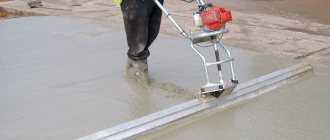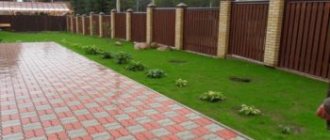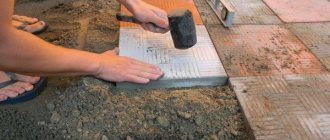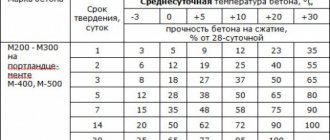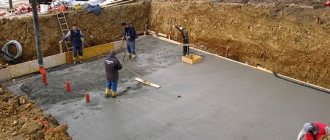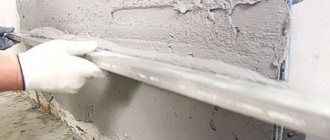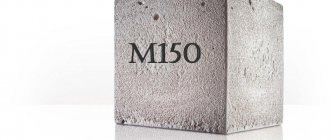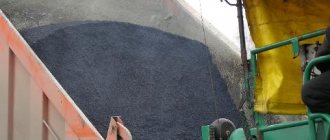Cast asphalt concrete
(English Mastic asphalt, German Gussasphalt) - road building material, one of the types of asphalt concrete; cast asphalt concrete mixture hardened during the cooling process and formed in the coating.
In accordance with GOST R 54401-2011 “Hot cast road asphalt concrete. Technical requirements" cast asphalt concrete mixture - "cast mixture, with minimal residual porosity, consisting of a grain mineral part (crushed stone, sand and mineral powder) and viscous petroleum bitumen (with or without polymer or other additives) as a binder, laying which is produced using injection molding technology, without compaction, at a mixture temperature of at least 190°C.” Depending on the temperature, as well as the magnitude and time of application of the load, cast asphalt concrete manifests itself as an elastic-elastic and visco-plastic material [1]. The difference between cast polymer asphalt concrete is that they are produced using bitumen modified with polymer additives, polymer-bitumen binder (hereinafter referred to as PBB).
Application in various countries[ | ]
The prototype of cast asphalt concrete can be considered natural asphalt, which was used in Babylon and Nineveh. This material began to be used in European cities at the beginning of the 19th century. For this, bitumen-containing limestones found in fields in France (Seyssel), Germany (Limmer) and Switzerland, containing from 5 to 20% natural bitumen or heavy oil, were used. Large metal cauldrons were used to “cook” natural asphalt, and the mixture was laid by hand. In 1829, cast asphalt concrete was laid for the first time in Lyon, and then the laying of sidewalks and bridges with cast asphalt concrete began in major capital cities (London and Paris). The use of the new coating had both positive and negative properties. City pedestrians were dissatisfied with smoking asphalt boilers and soles sticking to the asphalt in the summer heat. However, the use of cast asphalt made it possible to significantly reduce the noise when moving horses and carts. Conversation became possible within the crews themselves. On those streets where cast asphalt was laid, traffic became so quiet that the sudden appearance of a carriage frightened the townspeople, accustomed to the roar of approaching carts.
In the 1910-1950s. In the 20th century, cast asphalt concrete found its greatest application in Germany, where installation methods and selection of formulations continued to be improved, and the scope of application of the material expanded. In 1908, the first cast asphalt concrete was laid in Berlin and Frankfurt am Main. Since the late 1920s, Trinidad asphalt from Peach Lake began to be used in cast mixtures. In the early fifties, the first paver for cast asphalt concrete was invented. In the autumn of 1954, mechanized laying of cast asphalt concrete was first tested on Siemensstrasse in Berlin.[2] Already in the 1960s, cast asphalt concrete was laid seamlessly, up to 12 meters wide, and its use shifted towards the construction of expressways. The largest project for that time for constructing a coating made of cast asphalt concrete was the 38-kilometer section of the Nuremberg-Frankfurt autobahn from Tenneloe to Schlüsselfeld. The so-called “Berlin recipes” used, saturated with crushed stone, ensured high roughness and long-term wear resistance. The TVbit6/60 standard in force at that time provided for the use of bitumen with a penetration of 15 to 65 units for cast asphalt concrete, or a mixture of road bitumen and natural Trinidadian asphalt. Natural sand, previously used for surface treatment, began to be replaced by crushed stone treated with bitumen.[2]
The Russian history of the use of cast asphalt is connected, first of all, with the discovery and development of natural deposits of bitumen-containing dolomites in the Volga region, in the Syzran region. Deposits based on reserves were estimated at 22 billion poods. In Russia, the asphalt business has developed since 1873, when D.I. Voeikov, together with zoologist M.N. Bogdanov, discovered sandstone impregnated with natural bitumen in the Syzran district. This made it possible to establish the production of tar and mastic from local materials of excellent quality. Syzran asphalt was stronger than its Western European counterparts and melted at a higher temperature. Natural asphalt (bituminous rocks) was processed in significant quantities into mastic at factories near the village. Farmers and villagers Pechersk Syzran district, including for casting briquettes, which are then melted at the place of placement in boilers. Both factories produced 800 thousand pounds of mastic in 1889. Simbirsk asphalt was cheaper than foreign (at the beginning of the 20th century, 1 pood on average cost 35 kopecks), and in terms of quality it was considered the best in Europe. At the end of the 19th century. - early 20th century asphalt was purchased by cities such as Moscow, Kyiv, Nizhny Novgorod, Saratov, Astrakhan and others.[3] All of the above types of cast materials had a vague resemblance to the currently used compositions, however, the practice of improving them, searching for optimal ratios of the mineral part and bitumen, and additionally introducing sand and crushed stone, continued to develop.
Several scientific centers were engaged in modern research into cast asphalt concrete in the USSR. However, unlike West Germany, cast asphalt concrete was not widely used in the USSR. Prominent scientists, specialists - road workers and bridge workers of the State Unitary Enterprise "NIIMOSSTROY", the Moscow Automobile and Highway State Technical University (MADI), the Institute "Giprotransmost", Federal State Unitary Enterprise - have been engaged in the development of compositions and technology for the use of cast asphalt concrete, studies of the stress-strain states of the multilayer structure of the road pavement of bridge structures SoyuzdorNII, Saratov State Technical University and many others.
Cracks based on asphalt
As we have already discussed, cracks are the most serious problem associated with asphalt pavement. The interesting thing is that there are many types of cracks, and there are still many reasons for their occurrence.
- Longitudinal cracks. They appear on sites quite often, since their occurrence is associated with so-called seasonal changes in climate. Today we have dry weather, and tomorrow the humidity reaches record levels. This situation has a strong impact on such pavements, especially if the asphalt thickness is small. In addition, there may be air voids in the asphalt, which are often the main cause of small cracks. The good news is that these cracks do not particularly affect the performance of the pavement, so only the external component of the asphalt comes to the fore. It is obvious that over time the situation may worsen significantly in all directions. Therefore, it always makes sense to protect yourself from such unfavorable conditions.
- Crocodile cracks. Over time, the asphalt surface itself begins to lose its basic properties. Cracks called “crocodiles” are often called fatigue cracks. Asphalt simply oxidizes and can no longer be called a reliable coating. Often in this case, small cracks also form throughout the entire coating area. It is also impossible to exclude breaks in the connectivity of layers, which could result in extremely serious consequences.
There are many other situations in which asphalt loses its most important properties. The situation is such that in private areas, where very few people walk on the asphalt and there is almost no traffic, the surface itself loses important characteristics over a certain period of time. Accordingly, problems may lie not in broken asphalt laying technology, but rather over time. However, it is still possible to get rid of cracks or other imperfections in asphalt.
Classification[ | ]
The basic principles of classification of cast asphalt concrete are their division according to the size of the largest particle of the mineral material used in the composition (crushed stone fraction); purposes of using the composition; laying method. As a rule, in world practice the first of the three principles listed is used. It is used in German[4], Swedish (BRO 94 “Basic technical and structural requirements for roads”, chapter 6), Austrian (ÖNORM EN 13108-6), Swiss (SN 640440), Russian standards, as well as in the European standards series EN[5]. A classification based on the laying method (manual or mechanized) is used in Finnish regulations[6]. For example, the German classification of cast asphalt concrete according to the harmonized German standard TL Asphalt-StB 07 includes 6 main types: MA 11S; MA 8S;MA 5S;MA 11N; MA 8N;MA 5N .[7]
According to GOST R 54401 (Table 1), cast asphalt concretes, depending on the largest grain size of the mineral part and the intended use, are divided into three types.
| Type | Maximum grain size of the mineral part, mm | Content of fractions over 5 mm, % by weight | Recommended coating layer thickness, mm | Purpose |
| I | 20 | 30-51 | from 40 to 50 | New construction, major and pothole repairs |
| II | 15 | 15-30 | from 30 to 45 | New construction, major and pothole repairs, sidewalks |
| III | 10 | 0-15 | from 20 to 35 | Sidewalks, bike paths |
Classification and structure of cast asphalt
This material differs from conventional asphalt concrete in its increased content of bitumen, amounting to 7.5-10% by weight. And almost a third of the asphalt composition is mineral powder. Based on the size and quantity of crushed stone used, the material is divided into 3 types:
The strength of cast asphalt is determined by the properties of the binder or microstructure. This property distinguishes it from traditional asphalt, where the main role is played by the size and amount of sand and crushed stone. With an increased bitumen content, this mixture can be considered as a viscous liquid that does not require compaction.
Composition and structure[ | ]
Cast asphalt concrete differs from traditional asphalt concrete by its bitumen content increased to 7.5-10% (by weight) and the proportion of mineral powder increased to 20-30%. Thus, the content of asphalt binder (hereinafter referred to as ABB), consisting of mineral powder and bitumen, increases to 28% and higher. The content of crushed stone (grains larger than 5 mm) ranges from 0 to 50% by weight, which at a given concentration causes the formation of a semi-framework and frameless structure of asphalt concrete [8]. A key feature of cast asphalt concrete is that the strength of the material is determined by the rheological properties of the asphalt binder or the so-called microstructure[8][9].
In traditional compacted asphalt concretes, the so-called macrostructure (content and shape of crushed stone and sand) plays a much larger role in the formation of the physical and mechanical properties of materials [8]. The increased content of ABB determines the fluidity of cast mixtures, which, with the correct selection of composition, allows this material to be considered practically as a viscous liquid that cannot be compacted.
Internal structure of cast asphalt concrete compositions[10]
Requirements for source materials[ | ]
The Russian national standard for cast asphalt concrete (GOST R 54401-2011) sets out the requirements for the main components of this material.
- Binder:
GOST R 54401-2011:
“The binders used are petroleum road viscous bitumen grades BND 40/60, BND 60/90 according to GOST 22245, as well as modified and other bitumen binders with improved properties. When using cast asphalt concrete on bridge structures, in the upper and lower layers of road surfaces with high traffic intensity and design axle loads, polymer-modified bitumens are used. In these cases, preference is given to polymer-bitumen binders based on block copolymers of the styrene-butadiene-styrene type, grades PBB 40 and PBB 60 according to GOST R 52056.”[11]
- Crushed stone. To prepare cast asphalt concrete, crushed stone is used, obtained by crushing dense rocks, fractions from 5 to 10 mm; over 10 to 15 mm; over 10 to 20 mm; over 15 to 20 mm, as well as mixtures of these fractions. Several additional requirements for crushed stone - crushability grade of at least 1000, abrasion grade of at least I1, weighted average content of lamellar (flaky) and needle-shaped grains in the mixture of crushed stone fractions - no more than 20%. Crushed stone must meet the requirements of GOST 8267-93[12]. Particular emphasis is placed on the requirements for crushed stone used for surface treatment of the upper layers of the coating, which directly absorbs the load from vehicles, precipitation, and winter tire studs.
- Sand. As part of cast asphalt concrete, natural and crushed sands are used in accordance with GOST 8736-93[13]. The use of natural sand for top layers of pavement is limited in order to increase resistance to plastic rutting.
- Mineral powder must comply with the requirements of GOST R 52129-2003[14]. The possibility of a limited replacement of part of the mineral powder with stone dust from the dust collection system of an asphalt mixing plant is indicated.
- Additives introduced into cast asphalt concrete mixtures can be used to impart color (coloring pigments), improve the properties of the binder, and reduce the viscosity of the mixture and its temperature during laying (reflux condensers [15]).
Features of cast asphalt concrete
It is used for the construction of highways, pavement, bicycle and sidewalk paths. Each type of road has its own crushed stone fraction size (from 5 to 20 mm). Also, due to the properties of the mixture, it is often used for laying floors in residential and other premises, as well as for waterproofing.
The advantages of such asphalt pavement cannot be ignored. Unlike ordinary asphalt concrete, cast asphalt is waterproof. Due to the fact that the asphalt concrete mixture is not porous, water does not get inside the asphalt concrete and does not destroy it from the inside. It is also harmless and more environmentally friendly. This asphalt is not sensitive to high temperatures.
The undoubted positive qualities of the material include its durability. So, with proper use and preparation of the asphalt concrete mixture without violating the technology, the road will last 20, or even 30 years. It is not sensitive to salt and chemicals. Cast asphalt mixture is often used for pavement because it can absorb vibrations.
Ease of installation plays a big role in choosing an asphalt surface. Cast asphalt is laid at street temperatures down to -10 o, and this is due only to the comfort of the road workers themselves, and not to the properties of the mixture.
Photo source: house53.ru
Laying is carried out at an asphalt concrete temperature of 190-250 o. This high temperature contributes to the fluidity of asphalt. Its consistency is similar to mastic, so the asphalt itself is evenly distributed over the surface, without requiring a roller to compact it. To improve the coating characteristics, some companies add mineral powder modified with polymer additives to the mixture. This helps to increase or decrease the astringent properties of bitumen.
The coating is characterized by good adhesion, that is, the wheel does not slip on the surface even during rain. In Russia, the adhesion coefficient is increased by immersing crushed stone (5-10 mm) into a still hot, not hardened asphalt mixture. This paving technology protects the road from damage from studded truck wheels.
This material is suitable for installation on uneven surfaces or surfaces with complex geometric shapes. The mixture can also be easily painted in the required colors, the range of which is very wide.
Photo source: neruds.ru
Properties of cast asphalt concrete[ | ]
- Water resistance in the absence of moisture migrating through the thickness of the layer, which is typical for compacted asphalt concrete.
- A high degree of adhesion of cast asphalt concrete to the underlying layers, their “sintering” at elevated laying temperatures, including with roll-surfaced waterproofing materials. This property allows the coating and waterproofing system to function as an integral whole with the span structure of the bridge structure.
- High fatigue crack resistance (durability) under alternating loads under conditions of a wide range of frequencies and vibration amplitudes of artificial structures throughout the entire life cycle of the structural layer [16].
- The ability to dampen vibrations.
- No material corrosion effect, antibacterial resistance, salt resistance and environmental friendliness.
Cast asphalt concrete is low-flammable, does not spread flames[17], has half the thermal conductivity coefficient compared to concrete (0.7-0.9 W/mK), and is a vapor and sound insulating material (noise reduction up to 14 dB with a layer of 35 mm) [18]. The main advantages of cast asphalt concrete over traditional compacted asphalt concrete produced in accordance with GOST 9128-2009 are water resistance and fatigue life, the value of which increases several times when used in road bitumens modified with thermoplastic elastomers [15].
Disadvantages of cast asphalt concrete: increased cost of mixtures; the need for special equipment for the delivery and installation of material; poor resistance to plastic rutting due to unsatisfactory quality of composition selection in the laboratory or technological production errors; cracking in winter when unmodified bitumen with a reduced penetration rate (less than 50 units) and an increased Fraas brittleness temperature is used in cast mixtures.
Green cast asphalt concrete with embossed paving stones. Demonstration laying of cast asphalt concrete mixture on vertical surfaces.
Scope of application of cast asphalt concrete[ | ]
- Road construction, city streets in the tram area, sidewalks
- Bridge construction
- Coverings of parking lots and roofs in use (including heated ones)[19]
- Floor coverings in industrial and residential premises (including heated ones)[20]
- Waterproofing tanks and tunnels
- Waterproofing green roofs
- Grain and silo storage facilities, cowsheds
- Corrugated, colored, polished decorative coatings
Coatings are widely used in Germany in residential and industrial premises, including medical institutions.
Such coatings, prepared on the basis of brittle bitumen, have high bending strength, low thermal conductivity, environmental friendliness and lack of odor and dust formation. Cast asphalt concrete, laid in a layer thickness of 20 to 35 mm, is used in combination with dense heat and sound insulating materials on concrete and wooden floors[21]. Linoleum, carpet or ceramic tiles are laid on top of such coverings. Cast asphalt concrete for flooring in Germany is subject to technical standards[22]. The expansion of the use of cast asphalt concrete in Russia has been greatly facilitated by large bridge projects in which coating and waterproofing systems were installed using cast asphalt concrete. This is the construction of a bridge across the Volga in the village. Pristannoye (2000), Ladoga Bridge over the river. Neva near the village of Maryino (1998), construction of the Big Obukhov bridges of the cable-stayed system in St. Petersburg (2004, 2007), reconstruction of the Trinity Bridge across the Neva River in St. Petersburg (2002), Blagoveshchensky Bridge in St. Petersburg (2008), construction of overpass systems on the Ring Road around St. Petersburg (2008-2010), construction of the Ulyanovsk Bridge over the Volga River (2009) and dozens of other objects.
The bottom layer of the bridge deck is made of cast polymer asphalt concrete.
The practice of operating artificial structures shows that the durability of road surfaces on some large bridges in Russia is reduced by half after only 2-5 years. The destruction of the bridge deck coating layers leads to intense penetration of moisture, chemicals, and coating debris directly into the waterproofing layers and damage to the latter. The unsatisfactory condition of the roadway of bridges is one of the reasons for the destruction of structural elements of concrete artificial structures, as well as corrosion of the metal of orthotropic slabs of the roadway of metal bridges[23].
One of the reasons for the fragility of coatings is the use of a traditional multilayer structure on concrete spans, consisting of dissimilar materials: two layers of coating made of traditional compacted asphalt concrete (at least 90 mm thick) according to GOST 9128-2009 and a reinforced concrete screed covering the waterproofing layer. The water resistance of such a coating system and the degree of adhesion between layers are insignificant, which creates increased internal stresses in the materials. Operation of bridge structures in harsh climatic conditions, in conditions of vibration and exceeding permissible transport loads leads to premature destruction of such systems and significant costs for their repair
| This section is missing references to information sources. Information must be verifiable, otherwise it may be questioned and deleted. You may edit this article to include links to authoritative sources. This mark was set on November 1, 2011 . |
.
In SP 35.13330.2011. Set of rules. Bridges and pipes. The updated version of SNiP 2.05.03-84* regulates the possibility of using cast asphalt concrete as coating materials for the lower and/or upper layers of the pavement of the bridge deck on concrete and metal spans[24]. The document does not reflect the requirements for the type of bitumen binder used in cast asphalt concrete, and the use of compacted mixtures on PMB is prohibited. This ban does not correspond to the European practice of using polymer-modified bitumen, limits the practice of its use in the Russian Federation, and also potentially reduces the durability of coatings taking into account the harsh climatic conditions of Russia[25]. Cast asphalt concrete and cast polymer asphalt concrete, due to their inherent physical and mechanical properties, are widely used in world bridge construction as materials for covering the roadway of the bridge deck. Their use on concrete bridge structures makes it possible to abandon the traditional structure with a concrete screed, which reduces the load on the spans and increases the service life of the coatings. In many European Union countries (Germany, Austria, the Netherlands, Hungary, Finland, Sweden, etc.), cast asphalt concrete is also considered as an important element of the waterproofing system, applied directly to the main waterproofing material and ensuring the joint operation of the coating and spans due to a high degree of adhesion.
National German standards for the installation of coatings and waterproofing of artificial structures require the mandatory use of cast polymer asphalt concrete as a protective waterproofing layer[26][27]. In Germany, the use of a multi-level waterproofing system on metal and concrete bridge structures, consisting of a primer (bitumen-containing or epoxy), a protective-adhesive layer (fused-to-surface roll sheet or polymer-bitumen substance) and cast asphalt concrete, allows us to expect a service life of such systems without major repairs of up to 30 and more years.
Using asphalt concrete as a decorative material
Decorative asphalt mixtures
The advantage of the material discussed in our review, for example, in comparison with the same asphalt, is that it can also be used as a decorative element when creating road surfaces. For example, it can be used to make a covering on a sidewalk, alley, or walking path. When laying the road surface on carriageways, special markings for pedestrian paths are made from colored asphalt concrete. Also, thanks to the use of this material, dividing strips or other markings necessary for the safe movement of vehicles can be made on the roadway.
Decorative asphalt concrete is produced using the embossing method. It can also be obtained by corrugating or adding various mineral elements with different color shades to the main composition of this building material. The technological process that makes it possible to color asphalt concrete provides for the additional use of:
- colored crushed stone (the size of its fraction should not exceed 5 mm);
- special color pigments (crown, red lead);
- special sand made from minerals such as granite, clinker or marble. For the production of cast asphalt concrete, which contains bright colors, clarified or, for example, synthetic bitumen is used. It should be noted that the use of such technology significantly increases the cost of the roadway. Therefore, it is used in very rare cases. However, as an alternative, another method is used that makes it possible to obtain colored asphalt concrete at a lower cost. The whole point of this method is that colored chips begin to be rubbed directly into the coating itself at the time of its laying, and are not added during the preparation of the asphalt concrete mixture.
Statistics[ | ]
Every year, according to the International Association of Cast Asphalt Concrete Manufacturers (hereinafter referred to as IMAA)[28], from 800 thousand to 1 million tons of cast asphalt concrete mixtures are produced in Europe. Since 2004, Russia has been included in the IMAA. The largest European producing countries of cast asphalt concrete are Germany (389,728 tons in 2009) and France (216,505 tons in 2009), providing more than half of the annual total production. About 50% of all cast asphalt concrete produced in Europe is used as a waterproofing material, including as an element of a waterproofing system for bridge structures[28].
The production volume in Russia in 2010 is estimated at 45-50 thousand tons. Most of this volume is produced in St. Petersburg (from 30 to 35 thousand tons annually), and cast asphalt concrete is produced using polymer-modified bitumen. Cast asphalt concrete is widely used in the construction of the Western High-Speed Diameter, where it is used throughout the already constructed overpass sections as a protective layer of waterproofing.
Features of application[ | ]
The production of cast asphalt concrete mixtures is carried out on modern batch asphalt mixing plants. The mixture is transported to the place of installation in special heat-insulated mixers called Kochers (German Kocher - boiler, cooker), equipped with systems for forced mixing and maintaining a given temperature. In the heated state, the mixture is unloaded onto the prepared base in a liquid or viscous-fluid consistency, followed by leveling manually or mechanically. The cast asphalt concrete mixture is laid at temperatures from 190 to 250ºC with a layer thickness of 2.0 to 5.0 cm (with a weight of the laid coating from 50 to 125 kg/m2, respectively).
An integral part of the technology for constructing top layers of cast asphalt concrete pavements is the process of creating a rough surface with an appropriate adhesion coefficient using surface treatment. In Russian operating conditions, surface treatment with crushed stone additionally protects cast asphalt concrete from abrasive wear under the influence of studded car tires. On road surfaces, treatment is carried out by embedding fractionated crushed stone with a particle size of 5-10 mm or 5-20 (10-15) mm into the surface of the still hot asphalt concrete mixture. For additional embedding of crushed stone, light smooth rollers are used. When installing pavement and indoor floor coverings, treatment is carried out with a scattering of natural or fractionated crushed sand[29].
Surface treatment of the top layer of cast asphalt concrete pavement with blackened crushed stone
Technology for the production and laying of cast asphalt
Plant for the production of cast asphalt
Cast technology is based on the use of viscous grades of petroleum bitumen as binders.
Therefore, the preparation of the mixture occurs under the influence of relatively high temperatures:
- bitumen temperature - 160-180°C;
- mineral fillers are heated to 190-240°C;
- the temperature of the finished asphalt is 200-220°C.
The cast method of producing asphalt concrete eliminates its production in places where mixtures are laid, since the entire process requires precise adherence to temperature conditions.
Recommended temperature
Production
Schematic diagram of the production of cast asphalt
Technological instructions for preparing cast asphalt concrete:
- Cold and wet mineral materials, in calculated proportions, are loaded into the power unit, from where, using an inclined conveyor, the raw materials enter the drying drum. There it is dried and brought to operating temperature.
- The heated components are fed by the elevator into the sorting device.
- Sand and crushed stone, separated into fractions, flow through bunkers intended for hot material into dispensers and, upon completion of weighing, are loaded into the mixing unit.
- Cold mineral structuring powder is delivered by an elevator to the heater, where the substance is dried and heated to the optimal operating temperature, after which it enters the supply hopper.
- Dust (production waste) deposited in dust collectors is fed into a sorting unit, where it is dosed and mixed with sand and mineral powder.
- Hot bitumen from the heater enters the mixing unit, where it is dosed and fed into the hopper to the other components.
- In the main mixer, all components are mixed.
- After this, the finished products are loaded into special vehicles (kochers) equipped with a thermos boiler or a tank equipped with a system for heating and mixing the material at the time of delivery to the consumer.
Kocher machine
Laying asphalt
The construction of pavements from cast asphalt concrete mixtures must be carried out in dry and warm weather at a temperature of at least 5°C. Asphalt concrete at the time of laying should have a temperature of 185-235°C, depending on the technological conditions and the type of bitumen binder.
Cast coating
Work on laying cast asphalt takes place in the following sequence:
- preparatory work;
- unloading asphalt concrete;
- styling;
- distribution and pressing of black crushed stone.
Laying surfaces using an asphalt paver:
- A thermos mixer drives up to the stacker installed in the working position to transfer the solution into the unit’s hopper.
- Open the valve of the thermos, turn on the augers in the receiving hopper of the paver and drain the finished asphalt.
- After loading the normalized amount, installation begins.
- Asphalt is laid at a speed of 1–3 m/min. The speed is adjusted depending on the designed layer thickness. As the material is consumed, the operator adds it from a nearby kocher.
- In the event of a forced stop or end of a work shift, the solution must be completely worked out or removed from the receiving hopper, and the finished coating, at the site of the future joint, must be cut off with a thrust bar. During the next shift: the timber is removed, the joint is heated and the laying process continues.
Finishing device made of black crushed stone
Covering with black crushed stone
Black crushed stone is delivered to the site by dump trucks under a canopy or in a special insulated container. The material at the time of distribution must have a temperature of at least 100°C.
Crushed stone is laid using the sieving method at a rate of 10–15 kg/m2 on a hot base with a recommended temperature of 140–180°C. The material can be distributed either manually or mechanized (trailed crushed stone spreader).
Crushed stone spreader
The roller can begin operating after the coating temperature reaches 120°C. Vehicle traffic is allowed after the coating has completely cooled, but at least 3 hours after installation.
The cast asphalt concrete mixture is laid continuously and simultaneously across the entire width of the road, using the required number of pavers distributed in a ledge at a distance of 25–30 m from each other.
Test methods[ | ]
At the moment, in the Russian Federation, the list of methods for testing cast asphalt concrete is determined by organizational standards or technical conditions developed by manufacturing companies, the obligation to use which is assumed by the manufacturer. Cast asphalt concrete in Russia is tested for mineral porosity, residual porosity, water saturation, tensile strength at 0 °C, tensile strength at 50 °C, workability. In the European Union, the requirements for cast asphalt concrete contain functional requirements and, as a rule, do not contain specific numerical values for indicators of physical and mechanical properties, limiting themselves to classification according to a large number of quality criteria[30]. The final value of a particular indicator of the properties of cast asphalt concrete is determined in the design documentation for the construction site or can be declared by national annexes to the European standard (Nationally Determined Parameters)[31], as well as by the manufacturer. The main method for determining the rheological properties of cast asphalt concrete in most countries of the world is to determine the depth of indentation (penetration) into a sample of a flat stamp with an area of 5 cm² under a constant vertical load (52.5 kg). The test is carried out on cubic samples of material measuring 7.07×7.07×7.07 cm at a temperature of +40 °C for 30 minutes. The amount of deformation of the sample under the influence of load is measured with an accuracy of 0.01 mm. The European test procedure is based on the German method laid down in DIN 1996, chapter 13.
Device for determining the depth of indentation of a stamp
Technical regulation[ | ]
In May 2012, Russian standards for cast asphalt concrete came into force - GOST R 54400-2001 “Hot cast road asphalt concrete. Test methods" and GOST R 54401-2011 "Hot cast road asphalt concrete. Technical requirements". The standards are consistent with European regulations[32]. Currently in Russia there are a number of documents defining technical and technological requirements for materials and methods of installation work: organizational standards, technical conditions, technical recommendations, departmental building codes. The most well-known documents defining a set of requirements for cast asphalt concrete are TU 400-24-158-89* and TU 5718-002-04000633-2006 (SUE “NIIMOSSTROY”)[33]. These documents are criticized regarding the classification of cast asphalt concrete presented in them and the methods of their testing by supporters of updating the regulatory framework of the Russian Federation and its harmonization with European technical standards. In the European Union, regulatory documents EN 13108-6:2006, EN 12697-20:2003, EN 13108-20:2006 define the basic requirements for cast asphalt concrete and some methods for their testing.
Notes[ | ]
- Richard K. Shaffer, Dale B. Mellott.
Mastic asphalt concrete. — Pennsylvania: Dept. of Transportation. Bureau of Materials Testing and Research, 1972. - 28 p. - ↑ 1 2 Andreas Knobig.
Gussasphalt im Strassenbau-damals und heute (German) (inaccessible link).
BGA
. Gussasphalt magazine (2009). Retrieved September 22, 2011. Archived August 29, 2012. - Encyclopedia of Brockhaus F.A.
and Efron I.A. Asphalt (Russian) (inaccessible link -
history
). Russian State Library (1911). Retrieved September 22, 2011. - ZTV Asphalt - StB 01 Zusätzliche Technische Vertragsbedingungen und Richtlinien für den Bau von Fahrbahndecken aus Asphalt. — “Additional technical conditions of the contract and directives for the installation of asphalt road surfaces.”
- EN 13108-6:2006 Bituminous mixtures - Material specifications - Part 6: Mastic Asphalt. — “Bitumen mixtures Technical specifications for the material Part 6. Cast asphalt.”
- Finnish Asphalt Standards 2000 - Helsinki: Pavement Advisory Committee PANK.ry, 2000. - ISBN 951-97197-7-6
- The number indicates the maximum fineness of the mineral aggregate, in millimeters, when sieving on sieves with square-shaped cells. The letter following the number determines the traffic load class of the road.
- ↑ 1 2 3 S. N. Ivanchenko, N. I. Yarmolinskaya, A. A. Parfenov.
Ensuring the quality of asphalt concrete, taking into account the characteristics of the properties of the components and compaction technology. - Khabarovsk: Publishing house of the Pacific State University, 2006.-С82-83.-237 pp.-ISBN 5-7389-0450-8 - Rybyev I. A.
Asphalt concrete. - M.: Higher. school, 1969.-399 p. - In the top row, the structure of cast asphalt concrete is type 1 with a crushed stone size of no more than 15 mm. The bottom row shows a cross-section of a sample of cast asphalt concrete type 2 with a crushed stone size of no more than 10 mm
- In European road construction practice, the use of bitumen and polymer-bitumen binders with penetration rates of 20/30 units is allowed. When using cast asphalt concrete as a floor covering in industrial and residential premises, bitumen with penetration rates of 10-20 units or less is used.
- GOST 8267-93 Crushed stone and gravel from dense rocks for construction work. Technical conditions. (undefined)
. Retrieved October 16, 2011. Archived August 29, 2012. - GOST 8736-93 Sand for construction work. Technical conditions. (unspecified)
(inaccessible link). Retrieved October 16, 2011. Archived August 29, 2012. - GOST R 52129-2003 Mineral powder for asphalt concrete and organomineral mixtures. Technical conditions. (undefined)
. Retrieved November 1, 2011. Archived August 29, 2012. - ↑ 1 2 N.V. Maidanova, A.V. Pokrovsky.
Application of reflux condensers // Automobile roads. - 2011. - No. 5. - P. 120-122. Archived from the original on March 13, 2020. - S. K. Illiopolov, E. V. Uglova
. Durability of asphalt concrete pavements under conditions of increasing dynamic impact of vehicles. - Informavtodor. , 4/2007. - According to the European classification, cast asphalt concrete is classified as class Bfl-S1 in accordance with EN 13501-1 or as a building material category B1 in accordance with the German standard DIN 4102-4. According to the results of Russian certification tests, cast asphalt concrete has a flame propagation characteristic of RP1 (the lowest degree).
- According to the German company BGA
- DIN 18195 Bauwerksabdichtungen. — “Insulation of building structures”
- DIN 18560 Estriche im Bauwesen. — “Monolithic floors in construction.”
- DIN 18560-2 Estrich im Bauwesen, Teil 2 - Estrich und Heizestrich auf Dämmschichten. — “Monolithic floors in construction. Part 2. Monolithic floors and heated floors on insulating layers."
- DIN EN 13813:2003-01 - Estrichmörtel, Estrichmassen und Estriche - Estrichmörtel und Estrichmassen - Eigenschaften und Anforderungen. — “Solutions and compositions for monolithic floors. Properties and requirements".
- Ovchinnikov I. G., Makarov V. N., Ovchinnikov I. I., Rasporov O. N.
Problems of constructing modern road surfaces on bridge structures with an orthotropic and reinforced concrete slab roadway. //
Red Line
.-2009.-No. 39 /8.-C 42-47. - SP 35.13330.2011. SNiP 2.05.03-84* Bridges and pipes (Updated edition). — 2011. Archived copy from January 28, 2012 on the Wayback Machine
- ODM 218.2.003-2007. Recommendations for the use of polymer-bitumen binders based on block copolymers of the styrene-butadiene-styrene type in the construction and reconstruction of highways (unspecified)
. Retrieved October 16, 2011. Archived August 29, 2012. - TV-BEL-ST 92, Zusätzliche Technische Vertragsbedingungen und Richtlinien für die Herstellung von Brückenbelägen auf Stahl, Ausgabe 1992/1995, FGSV-Nr. 784/1
- ZTV-BEL-B und TL-BEL-B, Zusätzliche Technische Vertragsbedingungen und Richtlinien für das Herstellen von Brückenbelägen auf Beton ZTV-BEL-B Teil 3: Dichtungsschicht aus Flüssigkunststoff und Technische Lieferbedingungen für Baustoffe z ur Herstellung von Brückenbelägen auf Beton mit Dichtungsschicht nach ZTV -BEL-B, Teil 3, Ausgabe 1995, FGSV-Nr. 781/1/2
- ↑ 12
The Mastic Asphalt Industry- A Global Perspective. Final version EMAA/HSE Working Group. November 2010.-29 p. - GOST R 54401-2011 “Hot cast road asphalt concrete. Technical requirements", Appendix A
- EN 13108-6:2006 Bituminous mixtures - Material specifications - Part 6: Mastic Asphalt. (undefined)
. — “Bitumen mixtures Technical specifications for the material Part 6. Cast asphalt.” Retrieved October 9, 2011. Archived August 29, 2012. - Eurocodes database for Nationally Determined Parameters (NDPs database) (unspecified)
(unavailable link). — “Euro Database for Nationally Determined Parameters.” Retrieved November 1, 2011. Archived August 29, 2012. - Pokrovsky A.V.
On the development of GOST for cast asphalt concrete // Automobile roads. - 2011. - No. 2. - P. 38-41. Archived March 11, 2016. - GOST 8267-93 Crushed stone and gravel from dense rocks for construction work. Technical conditions. (undefined)
. Retrieved November 1, 2011. Archived August 29, 2012.

